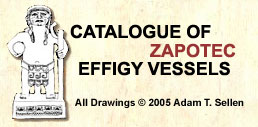| Key: MNA 6-6052 | | Actual Location: National Anthropology Museum, Mexico City, Mexico (exhibited). | | Registration: 6-52 | | Provenance: Offering of Temple 7 "deer", Monte Albán. | | Measurements: 74 x 74 cm. | | Chronology: MA II (Caso and Bernal, 1952: 202); Tani 200 - 350 AD (Urcid 2001: 133) | | Click to view Chronology | | Reference: Caso and Bernal 1952: 204, figs. 340, a & b; Urcid 2001: 133-147, figs. 4.34, 4.36, 4.37. | | Comments: According to Javier Urcid (2001: 137), this brazier with a U-glyph face is the tri-dimensional representation of a yearly date (13U) but it is also used as the calendar name of a governing human figure. The headdress worn by the human figure represents a sash that was tied to governors. This same sash, seen sideways, is used in Zapotec writing to designate the bearer of the year. This brazier was found with a smaller effigy that clearly belongs to the transition period; that is why we were able to suggest an alternative date to the one given by Caso and Bernal. See MNA 7 deer. | | Glyphs: Two bars and three numerals in the headdress. Glyph U mask (13U). | |
| | 
Click to view high resolution in a new window
select this image for review |
